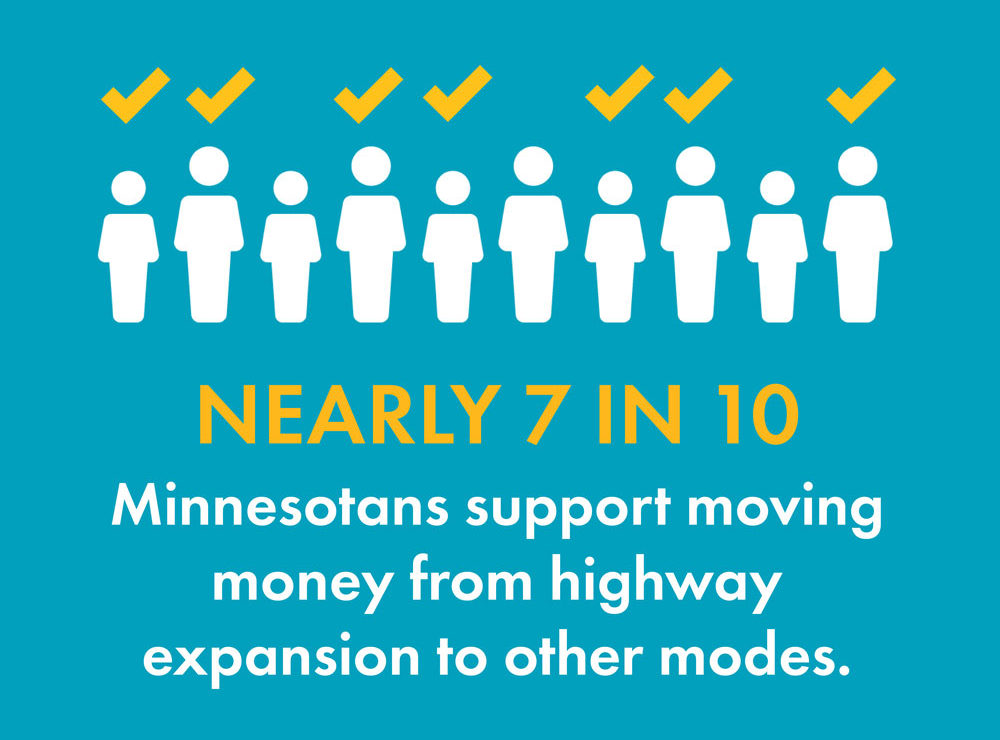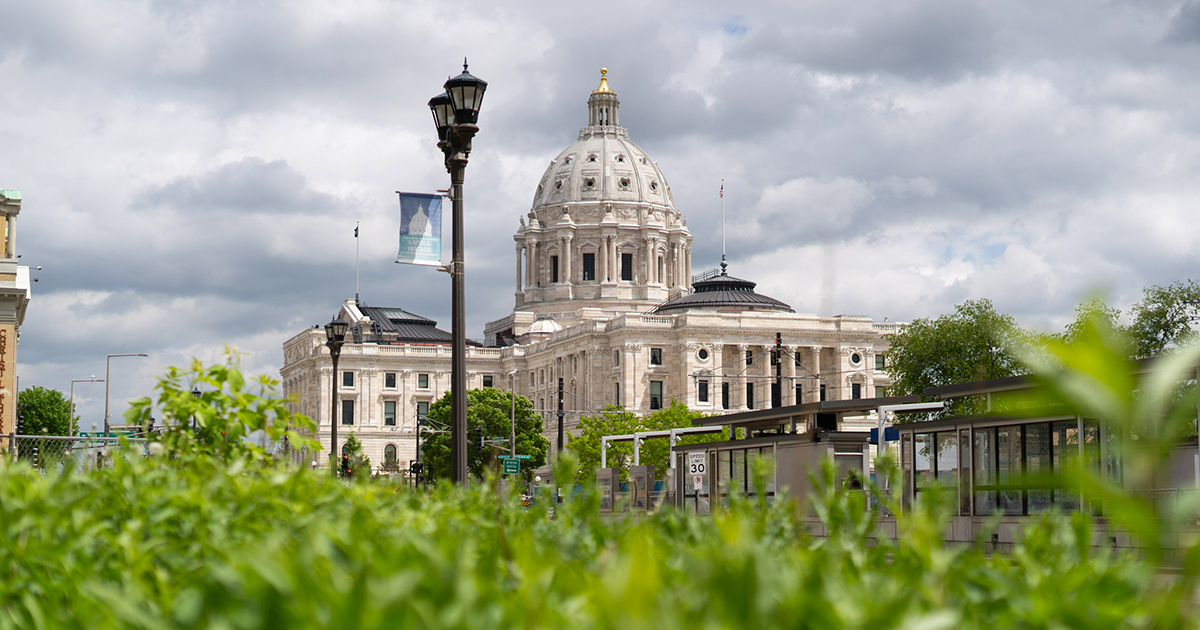How Move Minnesota is Leading the Nation to Curb Climate Pollution from Transportation
Our new win at the State Capitol builds on our nation-leading climate policy and moves Minnesota even closer to a healthy, sustainable future.
For the second year in a row, Minnesota has set a new standard for climate action in the transportation sector. After making headlines across the country in 2023, Minnesota made history again this legislative session by expanding a nation-leading law to curb greenhouse gas emissions from highway projects and setting a clear course to put the policy into action.
With support from our elected allies and national partners, Move Minnesota and Move Minnesota Action developed, fought for, and secured our Driving Down Emissions law in 2023, and successfully expanded it in 2024. Instead of endless highways that divide and pollute our communities, we knew this bold and innovative policy could put Minnesota on a new and better path.
Right now in Minnesota, we have 12,000 miles of major highways. And, while they make up just 8% percent of the state’s roads by mileage, nearly 6 of every 10 miles Minnesotans drive are on these highways. A full 58% of the vehicle miles traveled every year! So making significant changes to the way highway projects happen pays massive dividends toward reducing climate pollution and helping Minnesotans shift to more sustainable ways of getting around.
Thanks to our advocates and the hard work and leadership of Representative Larry Kraft and Senator Kelly Morrison, the law’s primary authors, we made tremendous progress this legislative session. After setting a ground-breaking baseline in 2023, this year we broadened our climate pollution policy to include, not just highway expansion projects, but every major highway project statewide.
“We knew last year’s historic win was just the first step. With this continued progress, we’re fighting the climate crisis with solutions that will make our communities healthier and more connected than ever.”
Sam Rockwell
Executive Director, Move Minnesota and Move Minnesota Action
This fundamentally changes the math for highway planning in Minnesota. By adding climate and vehicle miles traveled (VMT) requirements into the equation, it will curb unfettered spending on projects that accelerate the climate crisis and require investments in transportation options that put people and planet first.
Here’s how it works.
Setting the direction with strong state targets
While vehicle transportation is the largest source of greenhouse gas emissions, how we get around is often left out of policy conversations about climate action. For years, Move Minnesota has been educating community members, agency leaders, and state lawmakers about the critical role of reducing driving and increasing transit, bicycling, walking, and rolling to safeguard our climate.
But it’s one thing to acknowledge a problem. It’s another to set goals and take action. For years, Move Minnesota has been advocating for state officials to codify specific targets to reduce vehicle miles traveled in essential guiding documents. In 2022, we got two big wins.
- Through our participation on the Minnesota Department of Transportation’s (MnDOT’s) Sustainable Transportation Advisory Committee, we helped set specific goals to create a less car-dependent transportation system, including adopting a policy to “reduce the number of vehicle miles traveled [VMT] across Minnesota per capita 14% by 2040” in MnDOT’s 2022-2041 Statewide Multimodal Transportation Plan (SMTP), which sets Minnesota on a path to a 20% per capita reduction by 2050.
- The SMTP also established transportation-sector targets to achieve net zero greenhouse gas emissions by 2050—a goal consistent with climate pollution reduction goals set in statute. Both of these goals are also reflected and reinforced in the Minnesota Climate Action Framework.
These are the benchmarks that created the foundation of our landmark policy—the numbers that will inform whether a highway project is helping us achieve or getting us further from our stated goals to address climate change in Minnesota.
As we were securing these administrative wins, Colorado became the first (and only) state in the nation to pass a law that integrated climate impacts in the planning equation for any highway expansion project. We consulted with experts in Colorado, including colleagues at RMI, to craft a measure that leveraged our state targets and their innovative concept—and created a new model for the nation.
Securing the baseline in 2023
For decades, we’ve been cultivating relationships with state legislators and leading a powerful coalition to increase funding for public transit. Taking advantage of the political will and supporting landscape in 2023, we worked with new elected allies and longtime legislative champions to secure that funding and craft a complementary first-of-its-kind policy in the transportation bill that would shift the type of roads we build and the way our communities develop to secure a safer climate future in Minnesota.
So what did the 2023 law do exactly? It took the state climate benchmarks mentioned above and created a clear process to put them into action—for a certain set of urban planning and transportation projects.

First, the law requires the Minnesota Department of Transportation assess the climate and VMT impacts of any new highway expansion project—and ensure that it decreases both greenhouse gas emissions and vehicle miles traveled. That’s because increased road capacity has consistently been shown to increase driving rates through a phenomenon called “induced demand”—and the more we drive, the more climate pollution we emit.
Then, if the project fails to reduce pollution in line with state greenhouse gas and VMT reduction targets, the agency must cancel the project or find ways to reduce or offset that pollution with projects that give our communities more and better options to bike, walk, roll, and use public transit.
Expanding the policy to increase impact
From July 2023 to January 2024, we joined a group of experts and stakeholders—the Greenhouse Gas Emissions Mitigation Working Group—to discuss key aspects of the legislation and develop findings and recommendations to advance its implementation. In the February 2024 report, the working group emphasized that:
- Assessing the impact a single project will have on vehicle miles traveled is challenging with existing models,
- Assessing multiple projects together, in a portfolio approach, would allow for more accurate analyses,
- Local and regional governance bodies will need technical assistance implementing this law, and
- A technical advisory committee comprised of experts would help provide accountability and appropriate flexibility as the law is implemented.
In line with that analysis, and motivated to maximize the positive impacts for our climate and communities, we knew we needed to expand the policy so it applies to all projects on the state’s trunk highway system—not just expansion projects. We also knew we needed an action-oriented and vision-aligned advisory committee that included people with the right expertise and shared motivation to oversee the implementation of the law.
So we got to work during the 2024 legislative session, mobilizing community members to contact their lawmakers, testifying in key committee hearings, and working directly with elected allies to fine-tune bill language. And, despite a session marked by political division and unexpected interruptions, we secured another historic win: expanding the law so it will require greenhouse gas and vehicle miles traveled assessments on every major highway project statewide. Ultimately, this change means Minnesota is in an even stronger position to meet our urgent climate goals and to grow sustainable transit, biking, walking, and rolling options across the state.


The new law also:
- Allows the Minnesota Department of Transportation to collect greenhouse gas and vehicle miles traveled data from cities and counties across the state—a major first that will enable Minnesota to expand this law to all roads in the state in the future
- And establishes a technical advisory committee to provide support and accountability to move policy to action
So what’s next?
Minnesotans want healthy, affordable, and sustainable ways to get around—and they support policies that redirect resources to make it happen. Our 2022 statewide poll found that 66% of respondents support improving transportation options by “using funding from the state and federal government which would otherwise go to highway expansion.”

Right now, although federal Infrastructure Investment and Jobs Act highway funding can be “flexed” and used for multimodal investments, over $2 billion every year of State of Minnesota transportation resources can only be used for highway projects. We need to make it possible for state and local jurisdictions to flex these state dollars to invest in the more sustainable transportation system we need to strengthen our communities and protect our climate today and for the next generation..
In the 2024 legislative session we fought for that funding flexibility, and, thanks to advocates like you taking action, we elevated the issue with key lawmakers. The measure didn’t pass this year but we’ll be ready to hit the ground running when the legislature reconvenes in 2025.
In the meantime, the updated Driving Down Emissions law will take effect in stages.
- Now until 2027: MnDOT will develop a model to measure and predict vehicle miles traveled impacts of new highway projects—this model will be able to measure the ripple effects of highway projects on road systems throughout the state
- February 1, 2025: Assessment and mitigation requirements for trunk highway capacity expansion projects take effect, and
- August 1, 2027: Assessment and mitigation requirements for the full portfolio of Minnesota trunk highway projects take effect
So what does this mean for big highway projects? Read more here for what this process will look like—and how it will impact the Rethinking I-94 project in the Twin Cities.
Why it matters
In a nation of increasing political division, Minnesotans can be proud to live in a state where lawmakers and advocates can work together to advance groundbreaking policies to protect our climate and boost public transit. Climate change threatens the people and places we love, and our success in Minnesota is a strong reminder that solutions for a sustainable future are still readily available.
This new law is creating tools and integrating requirements that move aspirational targets to tangible actions, directly addressing climate pollution from transportation and land use and making it easier for people to walk, roll, bike, or bus. Thank you to the advocates and elected allies who helped us make this happen! Together, we’re continuing to make history, creating a new blueprint for more states and advocates across the country, and securing a healthy, connected, and equitable future for all Minnesotans!

